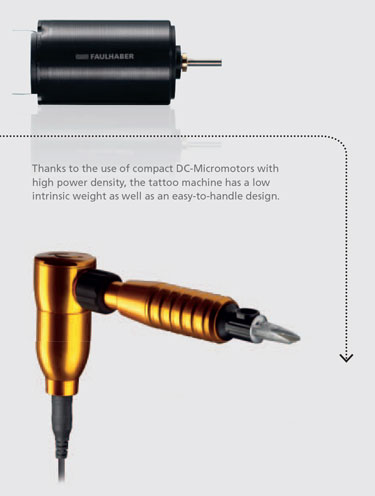 |
| July 15, 2014 | Volume 10 Issue 27 |
Designfax weekly eMagazine
Archives
Partners
Manufacturing Center
Product Spotlight
Modern Applications News
Metalworking Ideas For
Today's Job Shops
Tooling and Production
Strategies for large
metalworking plants
Engineer's Toolbox:
Technology that gets under your skin

For some years now, tattoos have gained mainstream acceptance. Just in Germany alone, there are about 5 million people who have a tattoo. Women are also now enhancing their beauty with "permanent make-up," whereby eyeliner or lip contours are permanently applied. What does this have to do with FAULHABER and MICROMO? In the handy machines used for tattoos and permanent make-up there are coreless DC motors.
Body art with a historic background.
Actually, the application of figures to the skin has a tradition reaching back thousands of years in a multitude of cultures. With needles or other sharp implements, people have long sought to permanently apply color pigments to the human body. For instance, numerous tattoos were found on the roughly 5,300-year-old Stone Age man "Ötzi," a Neolithic man whose mummified remains were found in 1991 on a mountain on the border between Austria and Italy. Tattoos have also been identified by archaeologists on the 4,000-year-old mummy of the Egyptian priestess Amunet. The archaic methods used for this tattooing were exceptionally painful, as the designs were carved into the skin using wooden implements, human bones, sharks teeth, or thorns. Nowadays, the procedures are much less painful, more hygienic, and of the highest technical standards -- especially if motors from FAULHABER are used in the tattoo machines.
Requirements
Tattoo professionals consider themselves to be artists; accordingly, their tattoo devices are the equipment with which they realize their art. They are occupied for many hours, without a break, when creating a large-scale tattoo. Modern tattoo machines are therefore characterized by a low intrinsic weight and the flexibility to adapt to individual movements. What is also desirable for the work procedures is that the device operates quietly and with low vibration, and that it fits the hand well.
At first glance, a tattoo machine functions similarly to a sewing machine: One or more needles oscillate and puncture the skin. The pigment is injected at the desired part of the body at a rate of several thousand pricks per minute. A seasoned tattoo artist neither punctures the skin too shallow nor too deep; ideally, he or she gets to the middle layer of skin. If the ink is applied too superficially, the tattoo will not be permanent; if the punctures go too deep, there will be bleeding, which would influence the dispersion of the injected pigment.

The underlying technology
Essentially, tattoo artists can choose between two types of machines: coil-based machines and rotary machines. Coil-based machines belong to the older generation and function somewhat like an old-fashioned doorbell in which a clapper strikes a little bell repeatedly in rapid sequence. This classic tattoo machine type works with alternating current, which constantly reverses the polarity of the magnetic coil, in turn moving the needle. The newest generation of tattoo machines works with high-performance electric motors. With them, the needle is no longer actuated by means of a coil, but instead by a motor. The advantages are that these so-called "rotary machines" are especially smooth running and significantly quieter than the coil-based machines -- and, thanks to their low intrinsic weight, they fit much better in the hand.
In these angular devices, the motor is located in a cross-piece and drives an eccentric mechanism in order to linearly oscillate the injection needle. This requires a thicker and shorter DC motor. These are available in FAULHABER's product range in various versions and technologies. Depending on the model, the drives just barely weigh 20 g (.04 lb) to 60 g (.13 lb), yet they can deliver the necessary performance thanks to their high efficiency factors of up to 86 percent.
Enduring, but not everlasting
Permanent make-up was developed from tattooing and refers to an enduring outlining of features, such as eyes or lips, by means of micro-fine color pigments. In contrast to a tattoo, permanent make-up is not irreversible, because modern technology makes it possible to color just the uppermost layer of skin. The result lasts about five years. The professionally and enduringly applied cosmetic art is viewed with increasing interest in our world, which places a great deal of value on beauty. Beyond the aesthetic aspects, permanent make-up can also cover up small imperfections and scars.
Precision in ballpoint pen format
Like the tattoo artists, cosmeticians who apply permanent make-up also benefit from having a light, handy device that they can operate with delicate precision. The color pigments are injected in the surface of the skin with an oscillating needle, whereby (in contrast to tattooing) only the uppermost layers of skin are treated, leaving the underlying tissue unscathed.
The devices that are employed in this application must meet the highest demands on technology and design, and moreover work precisely and reliably. As the most sensitive parts of the body, such around the eyes, are being treated, machines that run extremely smoothly are particularly necessary. Motors made by FAULHABER can also be successfully utilized in devices for applying permanent make-up. Because the devices are elongated and ideally have a format somewhat resembling a ballpoint pen, the slender models of the DC motors have proven themselves.
Unique solutions
Based on their technology, FAULHABER motors are distinguished by a high efficiency, which is not only an advantage for battery-operated devices. As a result of the high power density, more compact and lighter drive solutions are possible: a diameter of 13 mm for permanent make-up handpieces. FAULHABER models are differentiated from conventional DC motors by the rotor. It is not wound around an iron core, but instead it consists of a copper coil manufactured with a self-supporting, skew-wound design. This provides for low rotor weights, very smooth-running operation, and a highly dynamic cogging-free action without the usual magnetic hysteresis losses associated with other technologies.
More than just technology
Of course, FAULHABER has more to offer than just technology. Apart from their drive systems, many customers appreciate the company's comprehensive product service, such as customer-specific modifications that can be made to the shaft or the connections and plug connectors, even for relatively small quantities. FAULHABER also scores when it comes to accessories. Many components are combinable without any problems, which is not only important to the manufacturers of tattoo machines.
Want more information? Go to www.micromo.com.
Source: MICROMO
Published July 2014
Rate this article
View our terms of use and privacy policy
